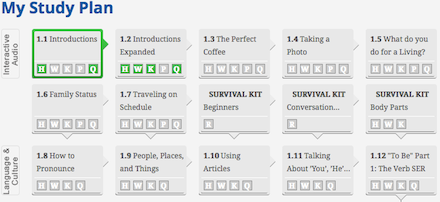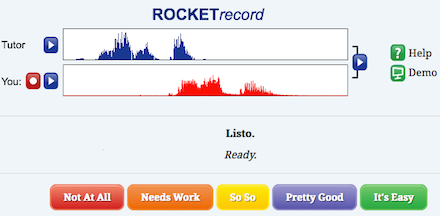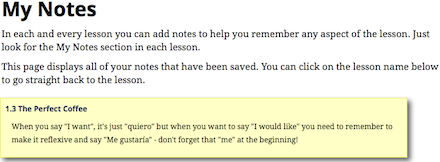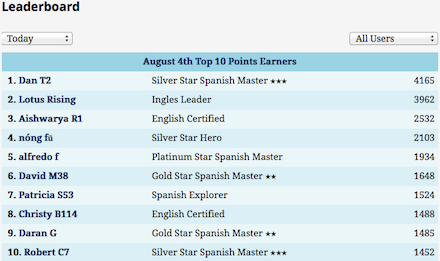Perspective: A beginning Spanish learner
As with all my reviews, this one will be written from the perspective of a beginning Spanish learner, one which I am intimately familiar with as I have spent quite a bit of time as one, during which I tried a good number of various courses, books, products, and techniques. I’m going to tell you how I personally felt about the course, what my own experience with and reaction to it was. I feel this is likely what will most interest and help you so this is how I’m doing it.
To be clear: yes I bought this course. They did not give me a free trial or solicit me to do a review. I bought it and actually spent several weeks using it and playing around with all the various features of it, I’m quite familiar with it at this point. I have direct access to the entire course via their website and will include screenshots of whatever part of the actual course I’m talking about when relevant.
What I’m going to tell you in this review
- The Good: the aspects of it that I thought were definitely beneficial to a beginning learner…things I liked, in other words.
- The Neutral: stuff that I felt may or may not be appealing to someone depending on their own personal circumstances such as their time frame for learning it, their own personal learning style, etc. Things that I’m “meh” on but which you may like (or not), in other words.
- The Bad: potential downsides to and problems with the course. Some of these depended on who the learner was and what their requirements were – in other words they may not necessarily apply to you – whereas others were absolutely a negative regardless. What I didn’t like, in other words.
- Who this course is for: the types of people that I feel this course would be beneficial to such that it’s worth it to them to buy it, and why.
- Who this course is not for: the types of people that I feel this course would be a poor choice for – those for whom this might be a waste of money in other words – and why. I’ll also try to recommend some alternative products if I can.
- How I would use this course to help me learn Spanish: in other words, how I would integrate it into my overall Spanish-learning system along with everything else that I would be inclined to use such as watching Spanish-language TV shows and movies, listening to Spanish music, reading Spanish books, reviewing flash cards, using workbooks, talking to native speakers during language exchanges, using other courses, etc.
- My overall take on this product as a Spanish learner and someone who teaches others Spanish and, primarily, how to learn it on their own (that’s what this website is about!).
What I’m not going to bother telling you (because it’s probably a waste of your time and mine)
Basically anything you can find just by looking at their website, e.g. the tech specs (technical specifications such as file size and which devices it works on), all the science supporting their method (yes, they have studies and people in white lab coats saying they’re right, of course they do), precisely how their teaching methodology works, etc. as well as all the different packages and combos you can buy (do you want a small, medium, or large? the bronze, silver, or gold package, sir? would you like fries with that?) – I’ll leave the selling up to them.
You didn’t come here to get what you can already just get straight from their own site, you came here to get the perspective of another person (preferably someone who is/was in a similar position to you, i.e. a Spanish learner) and hear about what their own personal experience was with the course, so that’s what I’m giving you.
Let’s get started!
The Good
1. It teaches and emphasizes modern, everyday, spoken, Latin American Spanish: This is precisely what the overwhelming majority of Spanish learners are looking for. There are some exceptions, such as those in the U.K. who are more interested in learning Iberian Spanish (Spanish as it’s spoken in Spain AKA “Peninsular Spanish”), those who are, for whatever reason, more interested in learning written Spanish or the formalities of proper Spanish grammar (these are usually students who need it for a class, typically a university level one, or an exam like the AP exams in the U.S.). I have recommendations for these people towards the end of the article so if you’re one of them do please stick around regardless.
Having been learning Spanish for nearly five years now, watched hundreds of hours of modern, popular, Spanish-language TV shows and movies, and most importantly having many friends from Colombia, Mexico, and elsewhere who are native Spanish speakers and who live and have lived their entire lives in such Spanish-speaking countries, I can tell you the most vital aspect of this course is…
Yes, this is how people actually talk. Praise Jesus! A course that finally gets it right! They teach you to speak Spanish just as native speakers do right now in their normal everyday lives. They include the more formal and proper Spanish that you would need to know, that you would be expected to know, such as how to talk to someone you would typically be expected to be especially respectful of (your girlfriend’s grandmother, a police officer during a traffic stop, a potential business partner during a meeting, etc.), but they don’t include a lot of the outdated and unnecessary “old school” Spanish that a lot of courses and textbooks do. They do include, in fact this is the majority of what they teach, lots of informal, friendly, common speech. Yes, you learn the proper and more formal greetings of Buenos días (Good day), Buenas tardes (Good afternoon), and Buenas noches (Good evening). But you also learn “Hola, ¡que tal!”, which is how friends greet each other and would roughly translate to something like “Hey, what’s up!”. That’s what I’m talking about. So, nicely done there…
2. The entire course, all the material, is accessible via their website (which you can download it all from if you like) as well as on CD: This is how most people will want to use the course, just log into the website and start using it – everything is there for you and well organized. Any sort of audio or video file can be played/streamed directly on the site, there’s no need to download anything unless you want to, which you can and it’s very easy to do so (each lesson has links to download all the audio files and other material) if you want to, for example, listen to it on your MP3 player later while driving to work or exercising. You can also get the course in the form of CDs which makes sense for people without a good internet connection. They’ve really covered all their bases here: most people will just want the website while occasionally downloaded a lesson here or there to put on a MP3 player later, a few people will want to download the whole course, and a very few people will need the CDs.

(this is an actual screen shot from inside the course website, as I promised you above)
3. The record-and-compare-your-speech-to-a-native-speaker thingamajig: With all of the Spanish they teach you, they break it down into individual words and phrases below each lesson that you can practice each one individually like so:

Now, stick with me here. You see each one of those little blue “Play” buttons? Well clicking them expands it into this:

There are two recordings there that can be played and one which can be recorded onto: the tutor saying the phrase in question (in this case “Me llamo Amy”) and then the recording of you saying the phrase which, I’m pleased to say, you can record and re-record over and over again as many times as you like until you get it right.
This allows you to listen to the native speaker saying the phrase and then immediately repeat after them while recording it, and to then immediately play the native speaker saying it and then the recording of you saying it so you can compare them. Like I said you can do this over and over again, recording over the previous recording of yourself, as many times as you like until you get it right and sound just like the native speaker, which is ultimately the goal now isn’t it? Very cool!
3. The Roleplays
On a similar note are the roleplays where they have you act out the part of a speaker in a conversation that took place during the lesson (so yes, you’re already at least somewhat familiar with the conversation).

They’re teaching you how to take part in a regular Spanish conversation, which is what most people are interested in learning how to do, so props to them there.
4. The Scheduler:

It’s a small bar at the top of your homepage (which they call “My Dashboard”) that allows you to set up a schedule for your lessons. You pick which days of the week you want to do your lessons on and then when you do you earn points and those days turn green, whereas days you missed are grayed out and labeled as a “Missed Day”.

You can see I’ve selected Saturday, Sunday, and Monday as my learning days – you can select any combination you want – so if you look at the picture of the scheduler I took previously you’ll see Saturday is labeled as missed since I didn’t do anything whereas Sunday and Monday are green since I did, and all other days are “Pass days” where I’m not scheduled to do any lessons.
This serves as a fantastic way of keeping track of which lessons you’ve done, which ones you’re scheduled to do and when, which days you’ve successfully completed and which you haven’t. Most importantly: it’s a motivational device that keeps your ass in gear by helping you stay disciplined and on-schedule. Most people, myself included, have days where they “just don’t feel like it” and this does a great job of helping you overcome that and stick with it.
5. The ‘Study Plan’
All this is, is simply everything (all the lessons and supplemental material) laid out for you in logical, sequential order so that you can just start at the beginning and go straight through without having to worry about what to do next. They’ve already sort it out for you, though of course you can skip around to wherever you like, and this ‘Study Plan’ is placed right smack dab in the middle of your homepage (what they call ‘My Dashboard’) just below the scheduler that tells you what you’ve done and where you left off previously, so there’s no confusion about what lessons you’ve done and which ones are next and need to be done. Very simple, no confusion, makes perfect sense, and it’s super easy to use. Nicely done there.

Note that what you see above is only a small portion of it, it’s the first of 8 sections worth of lessons they have.
6. The testing: Wow. It’s extensive. And I mean that in a very good way, I think proper testing is an extraordinarily effective form of review that really cements what you just learned into your memory for you so you have the ability to recall it on demand later when you need it (such as when you’re trying to talk to someone in Spanish).
The way it works is that you’re tested in various ways on the material you just learned in each lesson and you rate it in one of 5 different ways based on how hard it was for you:
- Not At All.
- Needs Work.
- So So.
- Pretty Good.
- It’s Easy.
![]()
Simple.
There are 5 different ways that you’re tested, I’ll use the first as the example:
“Hear It Say It”: You hear a native speaker say a word or phrase from the lesson (it cycles through all of them), which you then record yourself saying and play back for comparison (you can, as before, do this as many times as you like), like so:

then you hit the blue “Reveal” button where it shows you what was said and its meaning, at which point you rate the difficulty using the buttons at the bottom:

You then do this with all the rest where you’re tested on your writing ability by having to correctly write (with correct spelling and accent marks) the word or phrase you hear the native speaker say aloud, your pronunciation and reading ability where you have to say a word out loud that you see written in front of you, a roleplay that’s much more intricate (and difficult if you choose) than the one shown earlier that was part of the actual lesson. In this roleplay you can choose from 6 levels of difficulty and you take part in an actual conversation such as this example from Lesson 1.3 (very basic stuff because it’s only the third lesson of the entire course):

and that’s just a portion of the conversation, I couldn’t fit the rest in. Last is a short multiple-choice quiz where you’re asked about factual details of the conversation (e.g. “What would Amy like to drink?”) and you have to answer in Spanish.
7. The forum: it’s a straight-forward internet forum like what you’ve probably used before (AKA a “bulletin board” if you’re really old-school) where you can not only converse with and get help from your fellow Rocket Spanish students who are also taking the same course but which also has Rocket Spanish staff members and instructors to help you with whatever you need (I kept an eye on it for a couple of weeks and noticed that they always replied very promptly, usually within an hour or so of a question directed at them being posted). It’s very active with several thousand threads and many new posts every day. Their staff is made up of Spanish teachers, native Spanish speakers, and tech support people (for any technical problems/questions you might have concerning the website, files, or software you can download).
It’s broken down into two main areas:
The Spanish area that includes the following sections:
- Conversations in Spanish where you can practice Spanish with your fellow students and get help from staff.
- Culture and Travel for discussion of anything related to the culture in or travel to Spanish-speaking countries.
- Spanish Feedback and Comments where you can leave feedback for the staff on how the course is working for you.
- Spanish Grammar
- Spanish Vocab
And the “General Area” for discussion of whatever random topic you like or for posting about any technical issues with the website; they also put any news and updates about Rocket Spanish here.
8. The note-taking function: at the bottom of nearly every page is a very simple note-taking function that allows you to write down notes about whatever you want which are then stored in your account for you for later reference. Here’s an example I wrote up for you from Lesson 1.3 where I made a note like what a beginner might about the distinction between saying “I want” and “I would like” in Spanish:

Simple but extremely useful.
Tired of listening to me talk? Check out the official Rocket Spanish website (read about the spec’s and features, try the free demo, etc.)
The Neutral
1. The badges and point system: some people will like this, others won’t care, but it certainly doesn’t cause any problems so if you like it, yay, if not then don’t worry about it. What it is, is a motivational tool where you get points for doing all sorts of various activities (lessons, tests, posting in the forum, etc.) and then you get badges for certain amounts of points, and finally you get ranked against all your fellow students like so:

Cool, but not really something that does anything for me personally (though I know there are a lot of people who love this sort of stuff and it’s a great motivational tool for them and that’s great, use it if that’s the case).
2. The ‘My Vocab’ tool: This is sort of like their own version of Anki (a popular electronic flashcard program I recommend) but not as good. I’ll just stick with Anki, thanks. Though I will say it does have the advantage of being able to easily and automatically add vocab from the Rocket Spanish lessons to it thereby allowing you to avoid having to manually enter it by hand like you would have to do with Anki.
3. ‘Advanced Learning Techniques’: This is just a big collection of articles on language learning that they have, though I will say I saw several good and potentially valuable pieces in there including articles covering both Professor Arguelles’ Scriptorium technique and his Shadowing technique, but of course all this information is available elsewhere online for free, so I don’t consider it a big bonus, but it is nice that they’ve condensed and organized it all for you there. Not a big deal but certainly not a downside either.
4. The games: They’re ok for what they are and I would say maybe a minor benefit since they do seem like they would be a great little way to get some Spanish learning done if you’ve only got a few minutes, like if you’re waiting in line at the bank or spending 45 seconds in an elevator or something like that. They’re just very simple little video games designed to teach/reinforce Spanish vocabulary and grammar, such as this one where you have to correctly arrange the letters of a Spanish word so the little spaceman can walk across the bridge to his spaceship:

Meh. They’re not a problem, certainly, but I can’t say I’m likely to use them at any point, personally.
Official Rocket Spanish website
The Bad
1. Not good if you’re interested in Iberian Spanish (Spanish as it’s spoken in Spain): Obviously since they advertise their course as one focused on Latin American Spanish, if you’re interested in some other type of Spanish then maybe that’s not such a good thing. Having studied both I will say that there is a significant difference between Latin American Spanish and Iberian Spanish – hell, there are big differences between the various types of Latin American Spanish, e.g. North Mexican vs. Colombian costeña vs. the Southern Cone/Argentinian dialects (there are tons of various dialects, multiple ones per country usually, in Latin America, there is no one single ‘Latin American dialect’ really, that’s just silly).
I will also say that this matters least for a beginner since, in this case, you’re learning just the very fundamentals of Spanish that are the same throughout the world. However, on the other hand, they are teaching a lot of slang and expressions in this course, many of which are only in common use in Latin America and not Spain, sooo…
It’s kind of a tough call and one you’ll have to make yourself. I do know that a lot of my readers are in the U.K. (they’re 2nd only in size to my American readership, Canada is 3rd if you’re curious) and in my experience Spanish-learners in the U.K. tend to be overwhelmingly interested in learning Iberian Spanish since they want to use their Spanish to speak to people in/from Spain due to the U.K.’s proximity to that country.
2. Not good for studying for a specific class/exam such as DELE/CEFR/AP: I mean, it’s ok for that purpose, but it’s not at all designed for it and there are lots of other study materials that are (search Amazon for “DELE”, “CEFR Spanish”, and “AP Spanish”), so if you’re interested in this course as something to help you with those then that’s fine – it will help with the speaking/conversational portions of it – but definitely keep in mind that it’s going to be a secondary supplementary type of material at best, and that at worst it might actually screw you up since those tests are focused on very proper, formal Iberian Spanish and this course teaches a mostly informal Latin American style of Spanish.
3. Saying that the basic level version of this course will get you to “good conversational level” is a bit of a stretch: Now, they seem to know better than to use the word “fluency” or “fluent” since that’s such a loaded word in language-learning/linguistics circles due to its lack of official definition (which is why no respected institute uses it and instead usually do a “competency level” type of system like *CEFR’s A1, A2, B1, B2, etc. scheme), but they do say that the basic level course will get you to a “Good conversational level” but they don’t really define what they think that is.
*CEFR is the Common European Framework for Reference of Languages, since I know you’re wondering – it’s the method of teaching, learning, and assessing languages set by a European Union Council Resolution that’s been used as the standard in Europe for evaluating language ability and has become the most common and accepted standard worldwide. Ability is ranked using a simple scale of ratings: A1, A2, B1, B2, C1, C2; with A1 being the most basic and C2 being the most advanced.
Look, here’s my assessment: I would say the basic level course will get you to the point where you can speak clearly at a normal conversational rate of speed with a native speaker about the subjects that were covered in that course. Now, do they cover a fairly wide swath of subjects in even just the beginner’s level course? Yes. Is it comprehensive enough such that after completing it you could talk with a native speaker about just about any normal everyday topic (news stories, family life, politics, etc.) and be able to express yourself as you wish and understand everything they say? No, not even close. It’s nowhere near that comprehensive and, frankly, to be fair to them it’s not really practical to make it that comprehensive since that would result in a much, much larger course with far more emphasis on learning and practicing new vocabulary (because that’s the limiting factor after you learn basic grammar, syntax, and pronunciation) than would be practical or than would really be appealing to most of their customers (who are just looking for a basic Spanish course to get them kick-started in learning the language, not a comprehensive we’ll-stuff-the-entirety-of-the-Spanish-language-in-your-head-for-you course).
If you’ll please keep reading, and especially pay attention to the below segments on who I recommend this course for and how I recommend you use it, you’ll get what I’m saying here and see that it’s not necessarily a bad thing. I just wanted to temper their vague claims of “you’ll be conversational!” with a little bit of detail and practicality. They’re not lying, they’re just being as optimistic as possible about the results someone might get with their product which is, of course, exactly what we’d expect an advertiser to do, it’s what all of them do, right? So you can’t really blame them for that, I think we all expect that when we know we’re looking at/listening to a sales pitch.
4. The record/compare function has a rather annoying quirk: That function I’ve mentioned enthusiastically several times already that allows you to record and compare yourself with a native speaker saying the same phrase? Yeah, it works fine and all but it’s got this annoying, stupid little problem with the way it works – note the blue play button on the far right side of the function in the screenshot below:

That plays both the native speaker saying the phrase and you saying the phrase…at the same time. Ok. What I think they meant to do here was allow you to hit just one button that plays the native speaker first and then immediately after that plays you, and that makes perfect sense. The problem is what it actually does is play them both at the same time so what you get is this garbled mess of both you and the native speaker saying the phrase at the same time. This isn’t particularly useful.
Now, is it a big deal? No: see the blue play buttons on the far left, one for each recording? Ok those play each individual recording one at a time, so you can just click the top play button to hear the native speaker and then the bottom one to hear yourself. No problem. It’s just that it’s initially confusing and kind of annoying (and dumb that they designed it this way) and they need to fix it.
5. It would be seriously improved with some graphics and, in particular, videos: this isn’t an actual aspect of the course as it exists that causes problems, just a complaint about something that doesn’t exist in it, does exist in other (admittedly more expensive) courses, and would be nice to have here. That’s all. Videos please!
6. The ‘MegaSpanish’ game wouldn’t work on my computer: they have a game you can download, I imagine it’s not much better than the others (not that I really care about the games so I don’t see this as much of a downside, but anyway…) but when I downloaded it to evaluate it for this review it constantly crashed and generated an error message.
Now, here’s the good news about that, interestingly enough: it gave me an excuse to test their customer service/tech support and I was very pleased with the results: I was contacted within an hour of sending an e-mail to them by one of their customer service representatives and told that the problem was that they just hadn’t updated the game to work with my particular version of OSX (the operating system Macs run, which to be fair to them had just been updated to the new version that was released about a week prior by Apple). Honestly I should probably have added this under the “The Good” section and labeled it “Good customer service” because it was.
Official Rocket Spanish website
Who This Course is For
- Someone more interested in learning to speak Spanish than read or write it (they do teach reading and writing but speaking is far more heavily emphasized).
- Someone specifically interested in learning Latin American Spanish.
- Someone who wants to learn the more informal, colloquial, common, everyday type of spoken Spanish that native speakers regularly use to converse (basically the Spanish version of the kind of English you probably use throughout most of your day to talk to friends and colleagues and such), including idioms, slang, and expressions (I think they might even have some curse words in one of the short little e-books they offer you but I’m not sure).
- A beginner who knows very little if any Spanish.
- Someone with regular internet access. Frankly you could probably get away with 56k dial-up since there aren’t any videos as part of the course. You can just buy the CDs, yes, so this isn’t really hard-and-fast but they definitely seem to be making the website version of the product the primary one with the best features, and of course you’ll need to use the website to access the forum.
- Anyone planning on traveling to a Spanish-speaking country sometime in the next 6-18 months or so – that’ll give you enough time to get through at least the intermediate level course plus work on your Spanish using other methods like my Telenovela Method and by practicing with native speakers via language exchanges held on Skype and such. By the time your trip rolls around you should be conversationally fluent or pretty close to it.
- Anyone who has Spanish-speaking friends, colleagues, or relatives they’d like to be able to talk to and understand using informal, everyday Spanish.
Look at the above list and figure out how many of those apply to you. They’re just criteria, and fitting one doesn’t mean you should buy it. It also matters how important each one is to you (maybe you have Spanish-speaking relatives but they’re in-laws and you hate their guts so you’re not really that interested in being able to talk to them except maybe to curse at them in their own native tongue).
Official Rocket Spanish website
Who It’s Not For
- Anyone who really wants to learn, specifically, Iberian Spanish. There are other courses out there that focus on that particular dialect like Rosetta Stone and Assimil.
- Anyone who’s more interested in learning to read, write, or merely comprehend spoken Spanish (you just want to be able to understand Spanish movies, music, etc.). For reading/writing I’d suggest the Practice Makes Perfect series you can find on Amazon and for listening comprehension I’d suggest Assimil because of their emphasis on doing a “silent period” where you just listen to and read the language for the first couple of months.
- Anyone who’s studying Spanish solely for a specific test, exam, or class (especially if it’s university-level). For a class, use the textbook and any other material specific to that course (notes, supplemental material like books recommended by the teacher, etc.) – that’s what you’re going to be tested on and your ultimate goal here is to pass the test (with the highest score possible), so it doesn’t make sense to waste your time learning things you’re not going to be tested on. If you’re studying for the AP Spanish exam here in the U.S., there are plenty of books specifically designed to help you study for that test you can find on Amazon. If you’re studying for the DELE/CEFR-Spanish (basically the same thing) exam, again, same story.
- Anyone who’s traveling to a Spanish-speaking country in the next few days or weeks and needs a crash course in Spanish right friggin’ now. For you I’d recommend Synergy Spanish and maybe a phrase book (this is the best one in my opinion and it’s dirt-cheap to boot).
How I Would Use this Course to Help Me Learn Spanish
I would use this course as one part of a whole Spanish-learning system where I would spend about 30 minutes a day doing a lesson from this course then I would spend maybe 45 minutes to an hour doing the Telenovela Method (where I learn Spanish from Spanish-language popular media like movies, TV shows, music, books, etc.), and then maybe another 30-60 minutes actually practicing the Spanish I learned that day and just practicing speaking Spanish in general by doing a language exchange with a native speaker (more on language exchanges here if you’re interested), so that comes out to 1.5-2 hours per day and that’s actually fairly minimal – you could easily stretch that to 3-4 hours a day if you wanted to (just make the Telenovela Method and language exchange portions longer and divide them up throughout the day, e.g. 1 hour in the morning, 2 after work, and then 1 more after dinner).
You’re not going to get fluent just from a course alone, I’ve honestly never, not once, heard of that happening, if for no other reason than the fact that a course can’t provide one absolutely essential and unavoidable step on the road to fluency: talking to native speakers. Yes, you have to talk to native speakers in Spanish, badly at first, in order to learn how to talk to native speakers in Spanish. There’s no getting around it. No amount of preparation or memorization or lessons will make you fluent so that one day, just magically, you’ll suddenly be able to pop out of your house and, never having talked to anyone before in Spanish, be able to talk just like a native. It doesn’t work that way.
So you have to use it in conjunction with other things. This is fine. Courses are great, I recommend you do get a basic Spanish course as a beginner because I’ve found most people need a well-designed, organized, and structured course to get them “kick-started” so to speak on their Spanish-learning journey. They don’t know how to learn a language, they’ve never done it before, and so they need guidance, they need people who have done this before and actually know what they’re doing to tell them “Ok, first learn this, then do this, and now this. Spend this long on A, this long on B, and this long doing C”, etc. That kind of thing. They way to do this is use a course like Rocket Spanish in conjunction with other learning techniques like watching Spanish-language TV shows, listening to Spanish-language music (like Shakira!), and, most importantly, talking with actual native speakers. And spending your first couple months doing a basic course like Rocket Spanish (official website) is a fantastic way to get just enough Spanish under your belt that you can actually start doing short, simple language exchanges with native Spanish speakers and they won’t have to try to teach you Spanish from scratch which takes a lot of the pressure off them and also makes you a lot less nervous since you know that you do in fact speak some Spanish, and correctly at that.
My Overall Take on this Course
It’s excellent for what it is. On a scale of 1 to 10 I’d probably give it about a 7.5-8.0 or so. It’s not perfect, but for the price asked for the beginner’s version (under $100 U.S. – they run deals and discounts from time to time so check their site to see for yourself what it is right now), it’s really good bang for your buck as we Americans would say, or excellent value for money as the British would say.
It’s very beginner-friendly, that’s who it’s oriented towards, it teaches modern conversational Spanish, which is what most people want, there’s a 60-day ironclad money-back guarantee that’s operated via a third party (Clickbank, that’s who you’re buying it through) so even if they’re thieving bastards or they go out of business the day after you buy it you’ll still be able to get your money back, once you purchase the course you not only get unlimited access to it via the website forever but you also get any upgrades they make to the course for free (forever). Overall it’s a very nice deal.
If, based on what you’ve read above, you think it might be a good fit for you, I’d tell you right now to go on over to their website (here) and either just outright buy it if you’re certain (can always just return it later if you don’t like it) or if you’re not then at least sign up for the free 6-day trial (it’s in the top menu bar on the far right).
Hope that helps, let me know what you think (comments, contact form, etc.), and best of luck to you on your Spanish-learning journey (it’s worth it, I swear, and at least mostly fun along the way!).
Cheers,
Andrew






